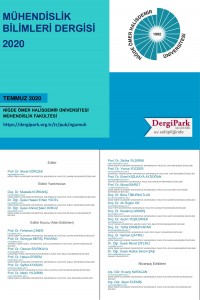FUNDUS FLORESEİN ANJİOGRAFİ GÖRÜNTÜLERİNDE YENİ KANAMA BÖLGELERİN BELİRLENMESİNE YÖNELİK YENİ BİR YAKLAŞIM : HIZLI YAPAY ARI KOLONİ ALGORİTMASI (Q-ABC)
Abstract
Diyabetik retinopati (DR) gözün arka kısmında ışığa duyarlı retina tabakasındaki kan damarlarının zarar görmesi sonucu ortaya çıkan ilerleyici bir hastalıktır. Kan damarlarının zarar görmesi kan sızıntılarına neden olabilir. Zarar görmüş kan damarlarının doğru bir şekilde tespit edilmesi hastalığın teşhisi ve tedavisi açısından son derece önemlidir. Zarar görmüş kan damarlarından dolayı göz üzerinde oluşan yeni kanamalı bölgelerin tespiti ve belirginleştirilmesi için Fundus Floresein Anjiografi (FFA) görüntüleme yöntemi kullanılmaktadır. Bu çalışmada, FFA görüntüler üzerinde DR hastalığı sonucu oluşan yeni kanamalı bölgelerin alanları bulunarak hastalığın seviyesini ve ciddiyetini tanımlamaya yardımcı olacak veriler elde edilmiştir. Göz görüntüleri üzerindeki yeni kanamalı bölgelerin tespitine yönelik hızlı yapay arı koloni algoritması (Q-ABC) kümeleme tabanlı olarak geliştirilmiş ve elde edilen sonuçlar kümeleme tabanlı temel yapay arı koloni (ABC) algoritması ile mukayese edilmiştir.
Keywords
Diyabetik retinopati Fundus floresein anjiografi Yapay arı koloni algoritması Hızlı yapay arı koloni algoritması
References
- R. N. Frank, “Diabetic retinopathy”, Progress in Retinal and Eye Research, vol.14, no. 1995, pp. 361–392. 1995.
- H. Özçetin, Pratik Göz Hastalıkları (2nci Baskı), F. Özsan Matbaacılık, 2000.
- J. A. Olson, F. M. Strachana, J. H. Hipwell, K. A. Goatman, K. C. Mchardy, J. V. Forrestera, and P. F. Sharp, “A comparative evaluation of digital imaging, retinal photography and optometrist examination in screening for diabetic retinopathy”, Diabetic Medicine, vol. 20, pp. 528–534, 2003.
- T. Walter, J. C. Klein, P. Massin, and A. Erginay, “A contribution of image processing to the diagnosis of diabetic retinopathy-detection of exudates in color fundus images of the human retina”, IEEE Transactions on Medical Imaging, vol. 21, no. 10, pp. 1236–1243, 2002.
- C. Jayakumari, and T. Santhanam, “An intelligent approach to detect hard and soft exudates using echo state neural network”, Information Technology Journal, vol. 7, no. 2, pp., 386–395, 2008.
- A. G. Karegowda, S. Bhattacharyya, M. A. Jayaram, and A. S. Manjunath, , “Exudates detection in retinal ımages using KNNFP and WKNNFP classifiers”, Artificial Intelligent Systems and Machine Learning, vol. 3, no. 7, pp. 419–425, 2011.
- A. Somasundaram, and J. Prabhu, “Detection of exudates for the diagnosis of diabetic retinopathy”, International Journal of Innovation and Applied Studies, vol. 3, no. 1, pp. 116–120, 2013.
- A. Kaur, and, P. Kaur, “A comparative study of various exudate segmentation techniques for diagnosis of diabetic retinopathy”, International Journal of Current Engineering and Technology, vol. 46, no. 1, pp. 142–146, 2016.
- F. D. Yağmur, “Yapay sinir ağları ile retinada hastalık teşhisi,” M. S. thesis, University of Haliç, İstanbul, 2008.
- A. Sopharak, and B. Uyyanonvara, “Automatic exudates detection from diabetic retinopathy retinal image using fuzzy c-means and morphological methods”, In Poc. The Third Conference on IASTED International Conference: Advances in Computer Science and Technology, 2007, pp. 359-364.
- A. Osareh, M. Mırmehdı, B. Thomas, and R. Markham, “Automatic recognition of exudative maculopathy using fuzzy c-means clustering and neural networks”, In Poc. Conference Proceedings of Medical Image Understanding and Analysis, 2001, pp. 49–52.
- E. Çalık, “Retina görüntülerinde yaşa bağlı makula dejenerasyonunun bilgisayar destekli tespiti,” M. S. thesis, University of Marmara, İstanbul, 2013. Available : http://www.who.int/healthinfo/global_burden_disease/en/ . [Accessed October 21, 2016].
- S. Wild, , G. Roglic, A. Green, R. Sicree, and H. King, “Global prevalence of diabetes estimates for the year 2000 and projections for 2030”, Diabetes Care, vol. 27, no. 2004, pp. 1047-1053, 2004.
- B. Antal, and A. Hajdu, “An ensemble-based system for automatic screening of diabetic retinopathy”, Knowledge-Based Systems, vol. 60, no. 2014, pp. 20-27, 2014.
- High-Resolution Fundus (HRF) Image Database. [Online]. Available : http://www5.cs.fau.de [Accessed April 28, 2016].
- D. Karaboga, “An idea based on honey bee swarm for numerical optimization,” University of Erciyes, Faculty of Engineering, Department of Computer Engineering, Tech. Report-TR06, 2005.
- D. Karaboga, and B. Gorkemli, “A quick artificialbee colony - qabc – algorithm for optimization problems”, In Poc. International Symposium on Innovations in Intelligent Systems and Applications’12, 2012.
- D. Karaboga, and B. Gorkemli, “A quick artificial bee colony ( q-ABC ) algorithm and its performance on optimization problems”, Applied Soft Computing, vol. 23, pp. 227-238, 2014.
- A. K. Jain, Fundamentals of Digital Image Processing, Prentice Hall International Editions, 1989.
Details
| Primary Language | Turkish |
|---|---|
| Subjects | Engineering |
| Journal Section | Others |
| Authors | |
| Publication Date | August 7, 2020 |
| Submission Date | January 1, 2019 |
| Acceptance Date | March 1, 2019 |
| Published in Issue | Year 2020 Volume: 9 Issue: 2 |

